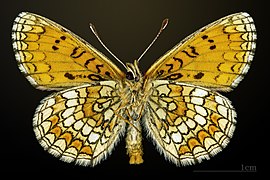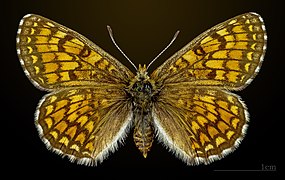Western pied butterfly
| Western pied butterfly | ||||||||||||
|---|---|---|---|---|---|---|---|---|---|---|---|---|

Western pied butterfly ( Melitaea parthenoides ) |
||||||||||||
| Systematics | ||||||||||||
|
||||||||||||
| Scientific name | ||||||||||||
| Melitaea parthenoides | ||||||||||||
| ( Keferstein , 1851) |
The western piebald butterfly ( Melitaea parthenoides ) is a butterfly (day butterfly ) from the noble butterfly family (Nymphalidae).
features
butterfly
The moths reach a wingspan of about 28 to 34 millimeters. They are intensely orange to brown-orange in color and have a pattern of black cube spots and cross bars. However, the mesh pattern is less dense and also finer than that of other butterfly species, which makes them different from them. Also noticeable is a particularly strong, black markings on the disk region of the forewings, while the disk region of the hind wings has only a weak mark. The palps are mostly fox-red. On the undersides of the hind wings alternating orange-yellow and white bands can be seen. At the edge there are whitish marginal moons, which then border on orange-yellow fields.
Egg, caterpillar, pupa
The egg is round and yellow in color. The caterpillars are plump, blackish in color, have numerous small, white spots and many yellow-brown or red-brown, thorn-like cones. The gray-tinted doll shows some very distinctive, white, button-like bumps on the back.
Occurrence
The western piebald butterfly occurs in southwest Europe, especially on the Iberian Peninsula , in southwest France , parts of the Italian Alps as well as in southern and southwest Germany and some regions of Switzerland . The species can be found on dry, short-grass, flower-rich mountain meadows and slopes as well as on wet meadows .
Way of life
The moths fly in dry, climatically favorable areas in two generations in May and June or in August and September. At higher altitudes only one generation appears in June and July. Usually the females lay the eggs in larger groups on the underside of the forage plant. The caterpillars are sociable at the beginning and overwinter in a web of dry leaves, after which they can be found individually. They feed on different types of plantain ( Plantago ), mainly ribwort ( Plantago lanceolata ).
Danger
The species occurs in some areas of southern and southwest Germany and is listed in category 2 (endangered) on the Red List of Endangered Species .
swell
Individual evidence
- ↑ Walter Forster , Theodor A. Wohlfahrt : The butterflies of Central Europe. Volume 2: Butterflies. (Rhopalocera and Hesperiidae). Franckh'sche Verlagshandlung, Stuttgart 1955, DNB 456642188 .
- ↑ Tom Tolman, Richard Lewington: The butterflies of Europe and Northwest Africa , Franckh-Kosmos Verlags-GmbH & Co, Stuttgart 1998, ISBN 3-440-07573-7
- ↑ Hans-Josef Weidemann: Butterfly: observe, determine , Naturbuch-Verlag Augsburg 1995, ISBN 3-89440-115-X
- ↑ Günter Ebert, Erwin Rennwald: The butterflies of Baden-Wuerttemberg Volume 1, butterflies I. Ulmer Verlag, Stuttgart 1993. ISBN 3-8001-3451-9
- ↑ Federal Agency for Nature Conservation (Ed.): Red List of Endangered Animals in Germany. Landwirtschaftsverlag, Münster 1998, ISBN 978-3-89624-110-8
literature
- Günter Ebert, Erwin Rennwald: The butterflies of Baden-Württemberg Volume 1, Tagfalter I. Ulmer Verlag Stuttgart 1993. ISBN 3-8001-3451-9
- Tom Tolman, Richard Lewington: The butterflies of Europe and Northwest Africa , Franckh-Kosmos Verlags-GmbH & Co, Stuttgart 1998, ISBN 3-440-07573-7
Web links
- Lepiforum e. V. - photos
- www.nic.funet.fi - dissemination
- www.faunaeur.org - endangerment
- Fauna Europaea - Taxonomy
- Melitaea parthenoides inthe IUCN 2013 Red List of Threatened Species . Posted by: van Swaay, C., Wynhoff, I., Verovnik, R., Wiemers, M., López Munguira, M., Maes, D., Sasic, M., Verstrael, T., Warren, M. & Settele, J., 2009. Retrieved February 18, 2014.



